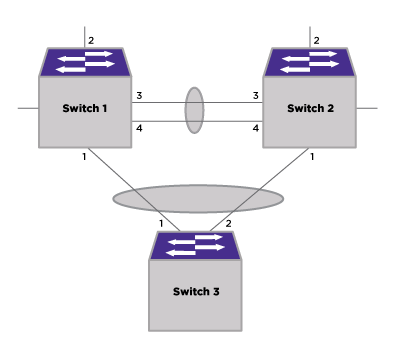Multiple VLAN Registration Protocol (MVRP) over Multi-switch Link Aggregation (MLAG)
This feature adds support for Multiple VLAN Registration Protocol (MVRP) on This command is available on all Universal switches supported in this document.. The objective of running Multiple VLAN Registration Protocol (MVRP) over MLAG is to propagate the VLANs across the MLAG peers and to have the VLAN database synced, so that the remote switches/servers continue to see a single logical connection.
Checkpointing

The primary reason for checkpointing is keeping the MLAG peers synchronized. The VLAN membership status of MLAG ports is maintained similarly through checkpointing.
- PDU checkpointing
- Bulk checkpointing
PDU Checkpointing
Each incoming MRP PDU on a MLAG port is encapsulated and sent to the MLAG peer through the ISC connection. On the MLAG peer, the packet is de-capsulated and processed by the MRP process as if received by the local MLAG port. This ensures that the local MLAG port on the peer is also added to the VLAN. The MVRP propagation happens normally in addition to the PDU checkpointing. In Checkpointing, Switch 1 and 2 are MLAG peers connected through ISC port (LAG ports 3,4). Switch 3 can send the MVRP PDUs to either Switch 1 or Switch 2 based on which MLAG peer is up. Assuming the MVRP PDU is sent to Switch 1, port 1 of Switch 1 is added to the VLAN and the PDU is checkpointed to Switch 2. If checkpointing is not done, port 1 of Switch 2 does not get added to the dynamic VLAN, since the MVRP PDU is not received on that port.
Bulk Checkpointing
When the MLAG peer comes up for the first time, bulk checkpointing of VLAN membership of the MLAG ports occurs. The peer that comes up sends a “pull” message to the active peer. Upon receiving the pull message, MVRP PDU is constructed for each of the MLAG ports and checkpointed through the ISC connection. Upon receiving the checkpointed PDU, it is decapsulated and processed as if it were received locally by the MRP process. This way the MLAG ports of the peer that came up gets added to VLANs. Bulk checkpointing is also done when MVRP is enabled on the MLAG port.
MVRP Packet Received on MLAG Port Process
- MVRP packet is parsed by MRP process.
- Upon successful parsing, the MVRP packet is encapsulated by the VSM and sent to the corresponding MLAG peer.
- The MLAG index is encapsulated along with the packet.
- In the remote MLAG peer, the packet is de-capsulated.
- From the MLAG index, the local MLAG port is determined.
- The MVRP packet is processed as if the PDU has been received by the local MLAG port

